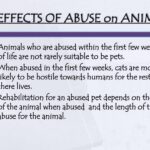Animal cruelty remains an egregious violation of ethical standards, combining neglect, abuse, and deliberate harm into a singular act that betrays our responsibility to protect those who cannot protect themselves. When we explore the legal ramifications of such acts, particularly felony animal cruelty, we uncover a complex judicial landscape that varies dramatically across jurisdictions. Thus, understanding the penalties associated with these crimes is crucial for both awareness and activism.
The term “felony animal cruelty” typically refers to severe forms of animal mistreatment, including but not limited to, torture, severe neglect, and intentional killing. While definitions may vary by state, the core of felony animal cruelty centers on the willful infliction of pain or suffering upon an animal. The penalties for such abhorrent behaviors can be harsh, reflecting a societal consensus that protects animal welfare. These penalties are not merely punitive; they reflect society’s moral stance, emphasizing compassion over cruelty.
In the United States, felony animal cruelty statutes vary considerably from one state to another. Some states impose sentences that can extend to several years in prison, while others may levy hefty fines or both. The severity of the penalties typically hinges on the specifics of the crime. For instance, if the act involves the intent to kill or maim, such as the torture of an animal or organized fighting of animals, the legal repercussions are significantly more severe than in lesser cases, like inadequate shelter or food.
For instance, in states like Texas, individuals convicted of felony animal cruelty can face up to two years in prison, with a fine that can reach $10,000. Similarly, California’s laws impose a potential three-year prison sentence for egregious cases. On the other hand, in some states, like Illinois, the penalties are even more stringent, allowing sentences of up to five years of incarceration for repeat offenders. The discrepancy in these laws often leads to discussions regarding the efficacy and uniformity of animal protection efforts across the nation.
Moreover, many states have begun to enact harsher penalties in response to public outcry and advocacy from animal rights organizations. Public awareness has surged, fueled by details of high-profile cruelty cases that have incited outrage. Social media campaigns and organized protests have raised awareness about the need for more robust legal protections for animals and stricter enforcement of existing laws. This dynamic interplay of public sentiment and legislative reform has, in some areas, resulted in a more proactive approach to punishing animal cruelty.
Another critical aspect to consider is the role of psychological evaluations in cases of felony animal cruelty. Some jurisdictions have begun to mandate psychological assessments for offenders. The rationale behind this is twofold: first, to understand the mental state that led to such inhumane behavior, and second, to implement rehabilitative measures that may prevent future offenses. Research has established a disturbing correlation between individuals who harm animals and those who may progress to committing violent acts against humans. Thus, addressing the root causes of animal cruelty is imperative, not only for the animals but for societal safety as well.
Sentencing in felony animal cruelty cases can also be influenced by aggravating or mitigating factors. Aggravating factors may include prior convictions for similar offenses, the number of animals involved, or the cruelty exhibited. Conversely, mitigating factors might encompass elements such as the offender’s lack of a prior criminal record, their expressions of remorse, or their motivation stemming from ignorance rather than malice. The presence of these factors can result in a wide range of sentences, from severe imprisonment to probation.
Additionally, many states allow for the provision of restitution to the victims, thereby spreading awareness about the financial ramifications of animal cruelty. Victims may include not only the animals themselves but also their owners, rescue organizations, and shelters that incur costs related to veterinary care and rehabilitation. The possibility of restitution serves as a reminder of the broader impact of such crimes, extending beyond the attributed penalty to encompass community engagement and responsibility.
In recent years, there has been a noticeable trend towards enhancing felony animal cruelty laws with provisions that aim to improve animal welfare broadly, including improved standards for breeding facilities, puppy mills, and pet stores. This shift acknowledges that our legal framework must not only penalize cruelty but also prevent future incidences through proactive legislation aimed at welfare improvements.
In conclusion, the penalties for felony animal cruelty are not merely legal consequences; they represent society’s collective answer to the question of how we value life—in all its forms. As public awareness grows and the fight against animal cruelty intensifies, the hope remains that legislative bodies will continue to harden their stance against such offenses, ensuring that the sentence not only reflects the severity of the crime but also educates the public on the importance of empathetic stewardship toward animals. It is imperative for communities to engage in continuous dialogue about these issues while advocating for stricter laws and better enforcement, fostering a culture of compassion that prioritizes the alleviation of suffering for all living beings.







